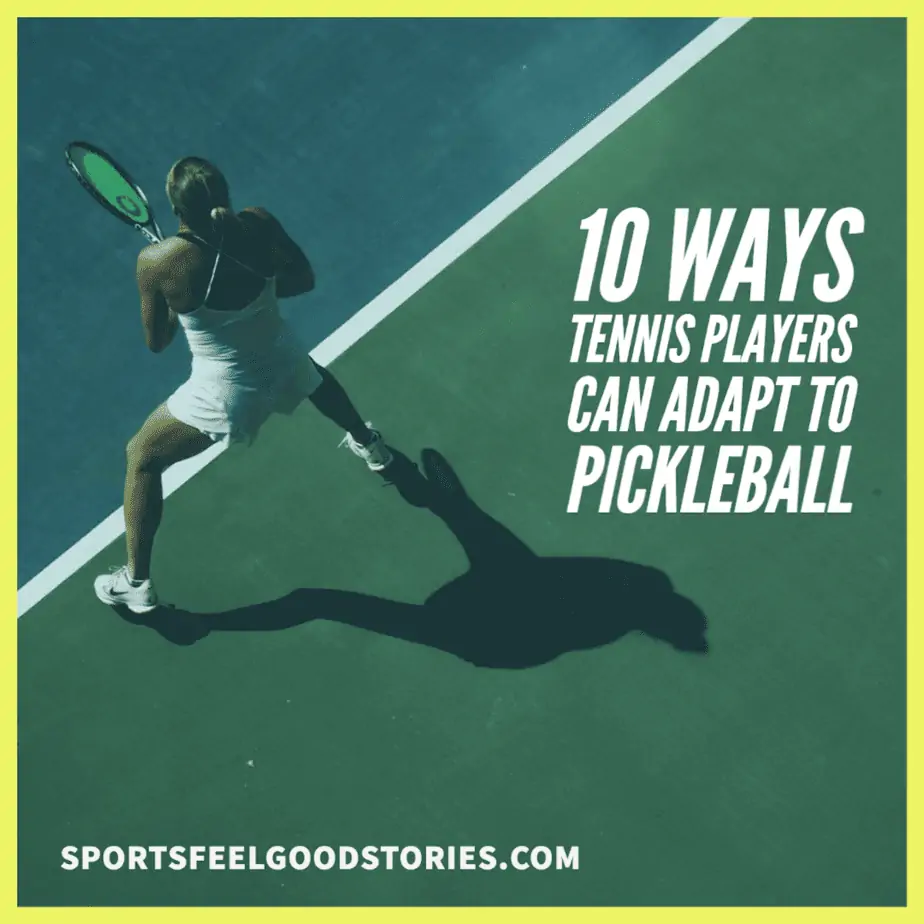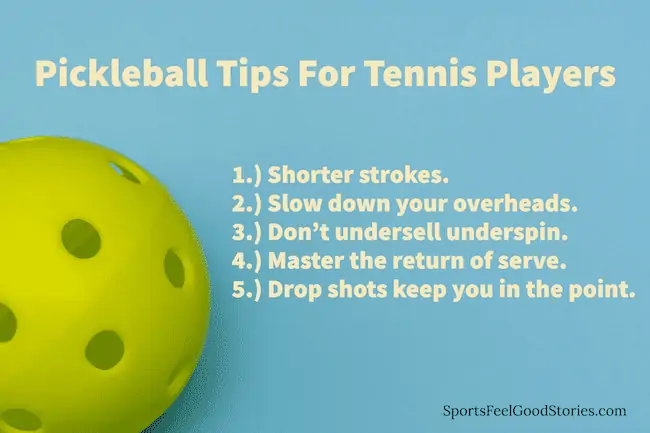Good tennis players make good pickleball players. The two sports’ similarities generally make for an easy transition for tennis players learning to play pickleball.
Hand-eye coordination, shot anticipation, understanding the importance of pace and placement, experience with volleys and overheads, and many other aspects of the sport of kings give tennis players a distinct advantage over most other pickleball beginners.
However, there are some fundamental differences above and beyond playing with paddles (instead of racquets), having a no-volley zone (commonly called the kitchen), and no doubles alley.
What follows is a deeper dive into aspects of the game of pickleball that tennis players will need to adjust for to improve their games.
10 Things Pickleball-Playing Tennis Players Should Know
These tips will help make tennis players learning pickleball adapt to the game more quickly.

1.) Shorter strokes for pickleball, folks.
A tennis court is 78 feet long, while a pickleball court is only 44 feet long. And, yes, while a pickleball has holes that slow down the ball, players still don’t need to hit the ball nearly as hard for deep, effective shots.
To accomplish this effectively, tennis players should shorten their groundstrokes. Don’t take the paddle back like you need to hit a ball for tennis. Shorter backswings will have you ready earlier and still provide ample power.
And it’s not only the length of the pickleball court that is shorter. It’s also considerably more narrow. You can’t be hitting that wide-angle shot that pushes your opponent off the court. Your shots will go wide.
Shortening your backswing will help you adjust to the court size. See Pickleball Court Dimensions and Rules.
2.) Slow down your overhead shots.
A funny thing happened to my ordinarily reliable overhead smash shot when I started playing pickleball — I started whiffing (not hitting the ball at all)!
Here’s what was happening: the holes in the pickleball slowed down my opponent’s lob shots to a point where I was just swinging too soon. The effect can be even more dramatic when playing pickleball outdoors with the wind behind your back. I frequently whiffed or barely made contact with the ball at the very top of the paddle.
I adjusted by slowing down my stroke. On some occasions, It felt like I waited for the ball to make contact with the paddle before beginning the descent of my overhead swing. Just going in with the knowledge that you can’t rush a pickleball overhead helps.
You might like our Best Pickleball Team Names with choices like Slice Girls, Dink Dynasty, and The Smash Bros.
3.) Go on the offensive whenever you can — pickleball tips for tennis players
Unlike the serve-and-volley play allowed in tennis, the service returners have the first opportunity to establish a presence at the kitchen line. The double-bounce rule of pickleball gives service returners a considerable advantage.
So, don’t sit back and admire your amazing return of service. Immediately get the no-volley-zone line and join your partner. It’s your best opportunity to win the most exchanges.
For the serving team, whenever there’s an opportunity to follow your shot to get to the kitchen line, take it. Fortune favors the bold.
See 43 Pickleball Strategies and Tips.
4.) There’s only a small opening to lob a ball.
To lob a ball has a place in pickleball, but it’s more difficult to hit lobs consistently well. Hit the ball too short, and your opponent backs up a few steps and smashes a winner. Hit a lob with too much oomph, and the ball carries out of bounds. There’s a narrow window where the lob works.
Still, a lob can be used defensively when other shots are less appealing or offensively if you catch an opponent by surprise – especially if everyone is at the NVZ line.
Practicing your lob regularly is key.
See Pickleball Shots You Need To Master.
5.) Don’t undersell underspin.
In tennis, topspin reigns. Topspin is also very effective in pickleball to keep the ball low, hard, and in play.
Underspin doesn’t play that big of a role in tennis exchanges. Sliced shots serve more as change-of-pace plays and seldom is a game changer.
Underspin is much more effective in pickleball than in tennis.
Opponents used to block returns into dinks that barely clear the net and suddenly see their shots hitting the middle of the net when faced with good underspin. If an opponent is having success hitting underspin shots to you, remember to counter by hitting topspin, another underspin shot, or simply aiming your return a little higher.

6.) Drop shots keep you in the point — pickleball tips for tennis players
Drop shots can be an effective tool in tennis, but hitting effective drop shots in pickleball is a requirement. For third shots and resets, placing the ball into the kitchen, just over the net, goes a long way. Learn those shots.
7.) You’ll need to make more determinations of whether a ball will stay in play or go out.
You’ll win many more points in pickleball than in tennis by knowing which shots not to hit.
Given the proximity of opponents in hand battles, you have to decide quickly whether to hit or not. Knowing when to let a long ball sail is a learned skill that can affect the outcome of many games.
See the Sports Feel Good Stories Pickleball Dictionary.
8.) Make your serves count — pickleball tips for tennis players
Tennis gives you two serves — pickleball, only one. For this reason, you must make the one-serve count.
Unlike tennis, for the most part, it’s tough to win outright on your service alone. However, you can lose your service by picking inopportune times to hit faults.
You can’t go wrong with consistent deep serves hit with pace like tennis. It makes it challenging for the returning player to hustle up to the NVZ line.
9.) Master the most important shot in pickleball: the return of serve.
As noted above, getting your serves in is critical. And much has been written about the importance of the third shot.
I’d make the case that the return of serve is even more critical.
You’ll win many matches if you can stop the other team from scoring consistently.
Why is the return of service so important? The returning team is in the best position to win because of the two-bounce rule. The return team is able to get to the kitchen line first and thus has the best opportunity to win an exchange. But, when you hit a return of serve into the net, deep or wide, you’ve given up that opportunity and given up a point.
Returns of serves should usually be deep and hit with pace. Hitting the ball down the middle gives the serving team the added obstacle of ensuring they’re on the same page regarding who is hitting the ball.
A well-struck return will put your team in an excellent position to win the exchange and stop the other team from scoring.
10. Remember, it’s a low-bouncing ball.
A plastic ball with holes doesn’t bounce up as quickly as a tennis ball.
Players need to get to the ball more quickly and prepare early to address this consideration.
The good news is you don’t have as much ground to cover as you do on the tennis court.
Final Thoughts on Tennis Players Playing Pickleball
Tennis is not only a gateway sport to pickleball but is probably the singular sport that best prepares one for the game of pickleball. The two games are way more alike than they are different. It’s for this reason that tennis players can make the transition quickly to pickleball and play successfully.
By Mike O’Halloran
Mike is a former tennis instructor who can now more frequently be found on the pickleball courts.
Overtime
You are on our 10 Ways Tennis Players Can Adapt To Pickleball page.
You might like:
